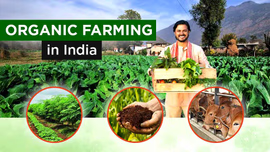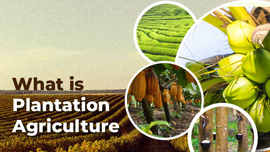Onion Farming in India: A Profitable Horticulture Crop to Grow in India

Onion is one of the most widely produced and consumed horticulture crops in India. Successful onion farming requires good agriculture practices at each stage of its cultivation starting from land preparation to harvesting. In this blog, we will be discussing all the cultivation stages in detail to help you understand onion farming.
Table of Content
- Introduction to Onion Cultivation
- Status of Onion Cultivation in India
- Different Varieties of Onion Grown in India
- How to Grow Onions: Step-by-Step Guide
Introduction to Onion Cultivation
An onion (Allium cepa) or a bulb onion is among the most widely cultivated species of the Allium genus. According to many food historians, botanists, and archaeologists, its origin is traced back to Central Asia. This vegetable has been a staple and an integral part of various culinary preparations since prehistoric times.
Onion farming is a highly profitable business activity for Indian farmers. Onion is cultivated in India throughout three crop seasons: rabi, kharif, and late kharif. Onions can be eaten raw as salads, or they can be cooked with different vegetables. Also, processed onion is a key ingredient of several value-added products, like dehydrated flakes, paste, vinegar, puree, rings, oil, juice, pickle and powder. The adoption of good agricultural practices at each stage of onion farming can help increase the overall productivity of onion.
Status of Onion Cultivation in India
India has the largest area under cultivation for onions and is the second-largest producer of onions globally. Indian onions are available throughout the year and are popular for their pungency. In 2023-24, the total production of onion in India stood at 242.12 lakh tons.
Also, India earns high income from the export of onions as it is a net exporter of the vegetable. From 4th May 2024, the onion export prohibition was lifted by the government by withdrawing 20% duty on its export. During FY 2023-24, the total onion export was noted to be 17.17 LMT, while the net export value was Rs.3,513.22 crore.
The major onion-producing states, along with production, are shown below:
|
State |
Production (Lakh Tons) |
|
Maharashtra |
86.02 |
|
Madhya Pradesh |
41.66 |
|
Gujarat |
20.57 |
|
Karnataka |
16.38 |
|
Rajasthan |
16.31 |
|
Bihar |
13.88 |
|
West Bengal |
8.85 |
|
Uttar Pradesh |
5.77 |
|
Haryana |
5.41 |
|
Andhra Pradesh |
5.13 |
Different Varieties of Onion Grown in India
|
Variety |
Name |
Characteristics |
|
White Varieties |
Pusa White round |
Flat & round shape, ideal for dehydration |
|
Pusa White flat |
Flat shape, medium to large bulbs, ideal for dehydration |
|
|
Bhima Shweta |
Round bulbs, 110-115 days to attain maturity after transplanting |
|
|
Bhima Shubra |
Oval to round bulbs, 112-125 days to attain maturity after transplanting |
|
|
Red Varieties |
Pusa Red |
Bronze-coloured, medium-sized bulbs, flat or globular shape, 125-140 days to attain maturity after transplanting |
|
Pusa Ratnar |
Bronze to red coloured, larger in size, globular, oblate to flat bulbs |
|
|
Pusa Madhavi |
Light red coloured, medium to large bulbs, 130-135 days to attain maturity after transplanting |
|
|
Pusa Ridhi |
Dark red coloured, compact, flat globe-shaped bulbs, rich in antioxidants |
|
|
Yellow Varieties |
Early Grano |
Globe-shaped bulbs, less pungent, suitable for growth in hills |
|
Brown Spanish |
Thick-skinned bulbs, less pungent, ideal for hilly regions |
|
|
Arka Pitamber |
Globe-shaped, yellow-coloured, uniform bulbs |
|
|
Phule Swarna |
Storage up to 4-6 months, less pungent |
How to Grow Onions: Step-by-Step Guide
Follow this guide to grow onions for maximum yield and earn high income:
Soil & Climate
All types of soil are fine for growing onion, but the most suitable is red to black loamy soil that is friable with good drainage and moisture-holding capacity with sufficient organic matter. The ideal pH range for onion growing is between 6 and 7.
Onion can also be cultivated in mildly alkaline conditions with a pH of up to 7.5. Under 6 soil pH is unsuitable for ideal onion growth. This is because onion crops are sensitive to highly alkaline, acidic, and saline soils. It is recommended to avoid growing Kharif onions on black and heavy soils.
Onion is considered a cool season crop. In the young stage, it can tolerate frost but cannot bear the heat. The ideal temperature range for this vegetable is 13-25°C. For a good vegetative growth, 15-21°C is needed before bulbing. 20-25°C is most suitable for the development of bulbs. Bolting is a physiological disorder that can be caused by very low temperatures in the beginning. The crop can mature early if there is a sudden temperature rise in rabi. Also, it results in small-sized bulbs. For ideal growth, development, and bulbing, there is a need for a minimum of 10 hours of light with ideal temperature. During monsoon, an average rainfall of 750-1000 mm is best suited for the growth of onions.
Land Preparation
Usually, onion seeds are planted in the nursery, and after around 30-40 days, seedlings are transplanted in the field. Plough the field suitably to remove debris and soil clods. A fine tilth can be achieved through 4-5 ploughing, and there should be a suitable interval between two ploughing. Shallow ploughing is recommended as onion roots do not penetrate deep beyond 5-6 cm. Then, divide the field into beds and channels. Prepare flat beds measuring 1.5 – 2 m in width and 4 – 6 m in length. In the case of drip or sprinkler irrigation method, prepare broad bed furrows (BBF) measuring 15 cm in height and 120 cm in top width, and there should be a furrow of 45 cm between two beds.
Planting
As mentioned before, onion seeds are planted in nurseries first and then transplanted in fields. Thus, onion cultivation involves two most critical steps: nursery management and transplanting. 0.12 acre of area is sufficient to prepare seedlings for 1 acre of onion plantation. Also, 2 to 4 kg of seeds are needed for this plantation area. Plough the nursery field to reduce the soil to finer particles and get rid of weeds, debris, and stones.
Similar to the main field preparation, apply a half ton of farmyard manure during the last ploughing. It is recommended to form raised beds at a 10-15 cm height and 1 m width for nursery preparation. For easy water drainage, the distance between beds should be at least 30 cm. 0.2% Pendimethalin can be used to control weeds in a nursery.
Transplanting of Onion Seedlings
- Procuring quality seedlings: Procuring a high-quality onion seedling from a nursery is ideal for transplanting in any season.
- Establishment phase: Transplant onion seedling after dipping roots in water solution made of carbosuphan 2 ml/ liter and carbendazim @ 1 gm for two hours. This will help reduce thrips incidences and fungal disease.
- Age of Seedling: Transplant kharif season nursery at 35 – 40 days of sowing, late Kharif at 40 – 45 days, and in Rabi at 50 – 55 days of sowing in the nursery.
- Spacing: The ideal spacing between the two rows is 15 cm, and between the plants is 10 cm so that plant population per unit area is maintained. As a result, one seedling gives only one single bulb and is of uniform size.
Manures & Fertilizers
For onions grown during the Kharif season, the recommended dose of chemical fertilizers per hectare is:
- Nitrogen (N): 75 kg
- Phosphorus (P): 40 kg
- Potassium (K): 40 kg
- Sulphur (S): 30 kg
For rabi and late Kharif crops, the dose recommended per hectare is:
- Nitrogen (N): 110 kg
- Phosphorus (P): 40 kg
- Potassium (K): 60 kg
- Sulphur (S): 30 kg
At the time of planting, 1/3rd of recommended N and a full dose of Phosphorus Pentoxide (P2O5), Potassium Oxide (K2O), and S are applied. The remaining 2/3rd N is applied in two equal intervals at 30 and 45 days after planting.
Remember to apply 30 kg of Sulphur per hectare if sulphur content of the soil is above 15 kg per hectare. Apply 45 kg of Sulphur per hectare if the sulphur content is below 15 kg per hectare. The recommended dose will result in the optimum production of onions.
In the case of the drip or sprinkler method, the fertigation method of applying fertilizers can be adopted as follows:
- Application of 40 kg N as basal dose at the time of transplanting and
- Remaining nitrogen in six equal splits at ten days interval from transplanting.
Weed Control in Onion Farms
Control of weeds at initial stages is highly critical for producing high marketable bulb yield. Effective weed control requires:
- Application of Pendimethalin @ 30% EC (3.5-4ml/L) 17 or Oxyflurofen @ 23.5% EC (1.5 -2.0 ml/L) before transplanting or at the time of transplanting.
- After 40 – 60 days of transplanting, hand weeding is required.
Irrigation
In general, onion needs irrigation at the time of transplanting, three days after transplanting, and subsequently at 8-12 days intervals depending upon the season, soil moisture status, climatic conditions, and soil type.
Irrigation needs to be stopped when the onion crop matures (10-15 days before harvest) and about 5% top starts falling, which helps in reducing the rotting during storage. Onion crops can be successfully grown using a drip or sprinkler irrigation system. In the case of sprinkler irrigation, good quality of water should be assured.
Harvesting of Onion Crops
The harvesting of onion differs as per crop cycle:
Rabi Harvesting Season
Harvesting is required when over 50-70% of the tops are down (neck fall). The bulbs are hand-pulled from beds along with leaves. They are covered with foliage of other bulbs for 3 to 5 days to be cured in the field. Also, the bulbs should not be exposed to the sun directly. After this, clipping of the roots and tops is done to make the bulbs dry and firm. A 2 to 2.5 cm stalk should be left above the bulbs after removing the tops.
Kharif Harvesting Season
Bulbs attain maturity in 90-110 days for kharif season. The different parameters that indicate maturity include pigment development, bulb size, and shape. 2 to 3 days before harvesting, empty barrels can be rolled to induce top fall mechanically.
Onion cultivation is a profitable agricultural business in India due to its ease of cultivation, potential for storage, and high demand. This vegetable is a staple ingredient in a variety of culinary dishes. Also, it can be grown across the country in a wide range of temperatures. Onion farming does not demand extensive resources or specialized skills, which is why a wide range of farmers can easily take up this agricultural activity. Overall, it can offer a good return on investment, mainly when this cultivation guide is followed along with high-yielding varieties.


Related Blogs












